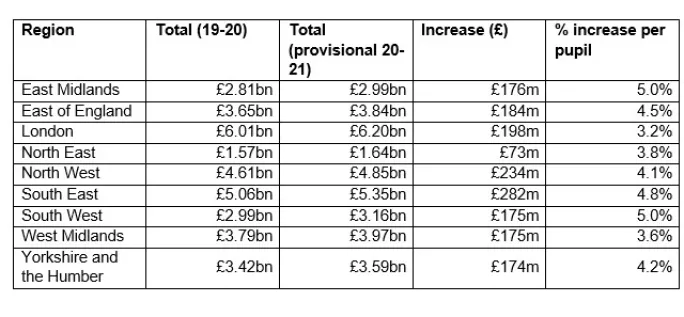Figures released by the Department for Education today reveal significant regional differences in the amount of extra per-pupil school funding increases being allocated next year.
Schools in London will receive an increase of 3.2 per cent per pupil while schools in the East and West Midlands will get 5 per cent per pupil (see table, below).
The extra money, which totals £2.6 billion for next year, is the first batch of three annual payments which by 2022-23 will amount to an extra £7.1 billion for schools.
Analysis: Why no government would renege on £7bn pledge
Williamson: Teacher pay will be ‘levelled up’
Tes Podcast: New funding and starting the new year
The DfE said today that every secondary school would receive a minimum of £5,000 per pupil next year, and every primary school will be able to receive a minimum of £4,000 from 2021-22.
Education secretary Gavin Williamson said the biggest increases would go “to the schools that need it most” and said it was “the biggest funding boost for schools in a decade, which will give every school more money for every child”.
However, Luke Sibieta of the Institute for Fiscal Studies think tank said there was no evidence to suggest money would go to schools that needed it most.
He said: “The introduction of minimum funding levels will mean that some of the biggest beneficiaries of this extra money are schools with the lowest levels of funding per pupil at present. However, there is no evidence to suggest these are the schools most in need.
“Up until very recently, these are the schools that the government assessed as needing the lowest levels of funding, largely because they contained relatively few pupils from deprived or underachieving backgrounds.”
Meanwhile, unions have criticised the amount of money as not being enough to keep up with inflation.
Kevin Courtney, joint general secretary of the NEU teaching union, said schools would suffer a funding cut because school costs rise faster than inflation.
He said: “The government claim laudable aims, but they must provide the funding to turn them into reality. In April 2020, four out of five schools will still have less per pupil than in 2015.”
Paul Whiteman, general secretary of headteachers’ union NAHT, said: “Despite hopeful headlines of more money for schools, many will be left disappointed by allocations that are likely to be worth less in real terms next year than this.”
The DfE has already announced that the money will include £780 million in 2020-21 to help children with special educational needs and disabilities.
But Geoff Barton, general secretary of the Association of School and College Leaders (ASCL), said this was “only about half of what is needed”.
He said: “We obviously welcome the extra money being invested in schools, but the government’s commitment is a long way short of what is needed.
“Despite the government’s over-hyped rhetoric, the stark reality is that the school funding crisis is far from over.”
Other education measures set out in recent weeks include a drive to create thousands more good free-school places nationwide - plus £4.4 billion committed over the next three years to continue to fund additional pension costs for teachers.






